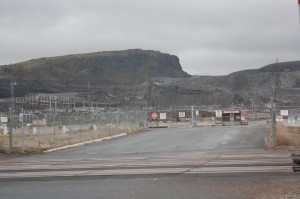As of November 5, 2011, some of the fuel stations in the Pocatello/Chubbuck area had dropped their gas prices to $3.29 per gallon. Yet diesel prices remain unchanged, still between $3.99 & $4.09 per gallon. Local gasoline prices had been falling steady for more than a week now, diesel has not.

Fred Meyer, Pocatello, Idaho
According to indexmundi diesel commodity prices have been falling ever since prices peaked in July, 2011. August saw a 5% drop, and September saw another 1% drop. In September the average daily commodity (New York Harbor Ultra-Low Sulfur No 2 Diesel Spot) price for diesel was $2.98 per gallon.

Phillips 66, near Kmart, Pocatello, Idaho
For those of you who continue to believe it has something to do with low sulfur refining, let me remind you that the commodity price is for already refined diesel.
Indexmundi also reports that refined gasoline commodity prices have been falling, also since their peak in July. Gas (New York Harbor Conventional Gasoline Regular Spot) has actually been falling more then diesel: August saw a 6% drop, September a 2% drop. The average daily commodity price for gasoline in September was $2.77.
Interestingly, The Associated Press reported in October that wholesale fuel prices went up, which contradicts the indexmundi web site.
Here’s the bad news for diesel users: When we look at the latest November commodity prices diesel has actually gone up; $3.06 as of November 1, versus gasoline commodity prices which were only $2.7o per gallon.
This might explain why diesel pump prices haven’t dropped, and why gasoline pump prices should continue to drop (unless you’re living in an area of the U.S. that’s actually seeing gas prices go up). The latest diesel commodity prices also indicate that pump prices will probably go up.
In a quick survey of international news stories, it seems diesel prices are going up because of growing demand around the world.
In the Indian state of Manipur, an economic blockade has caused fuel prices to jump by four times, since the blockade started on August 1. Basically there are people in Manipur that are seeking independence from India.
The Indian government controls the price of fuel in the country (it’s part of how the Indian government generates revenue for itself, and they’re hurting for more revenue), and is trying to hold off on raising diesel prices anymore: “It is always difficult to raise diesel prices as it is widely used by farm sector and industry for transportation. It is not perceived as a luxury fuel.”-Victor Shum, Purvin & Gertz.
On October 25, Reuters reported that China’s busy economy will drive diesel prices upward, and that fuel producers can’t keep up: “In the last 12 months China’s demand for diesel for power generation has been one of the major drivers (of the market). They do tend to step in and stockpile. We are not seeing any significant squeezes yet but this is a supply side story, if we carry on with this current trend we will have some problems in the light, sweet products. I don’t believe supply can keep pace.“-Tony Hall, Duet Commodities Fund
Don’t forget that Japan has seen half its nuclear power plants shut down since the March 11 disasters. Japan was almost totally dependent on nuclear power, now they are switching to other forms of generating electricity, and that includes diesel powered generators.
In South Korea demand for fuel, including diesel, has skyrocketed, and the government has approved the opening of 1,300 new fuel stations! Ironically the South Korean government thinks by opening more fuel stations (thereby increasing demand) they can provide cheaper fuel: “Nonghyup and the KNOC [both government controlled companies] will jointly buy fuel from local refiners or from abroad, so they can be sold to the thrift gas stations. Prices will be kept down further by the gas stations operating on a self-service basis, where the driver fills his or her car.”-South Korean government statement
Another reason for an increase in diesel prices is that petroleum supplies are falling behind.
There is a problem with a refinery in Indeni, Zambia. The refinery can not meet current standards of fuel refining, and needs U.S.$40 million to become compliant.
In Mexico, oil production has dropped. In September oil production was 2.863 million barrels per day, the lowest levels since October 1995!
In fact around the world oil production dropped by 7% in September. More specifically, diesel fuel production dropped by 12.7%!
In an earlier posting I explained how decreased gasoline production was the real reason for gas pump prices going up, now it’s diesel.
Like I said, bad news for diesel fuel users.





